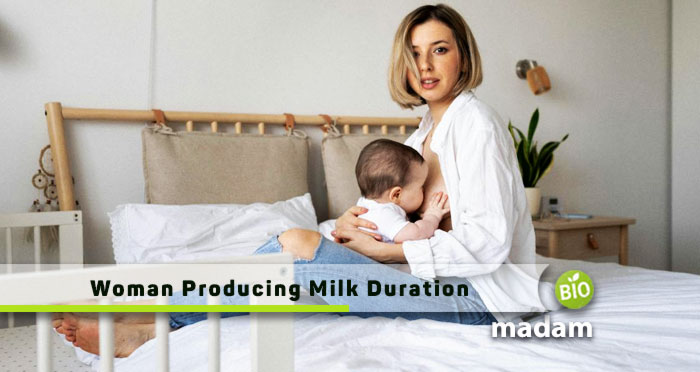The journey of motherhood unfolds with a tapestry of experiences, and nestled within this intricate fabric is the phenomenon of lactation. The ability of a woman’s body to produce and release milk, an elixir of nourishment for her newborn, is both miraculous and complex. Understanding the duration of this lactation journey is pivotal, influencing decisions related to breastfeeding, weaning, and the overall well-being of both mother and child.
Factors Influencing Breast Milk Production
Hormonal Changes
- Impact of Pregnancy: The genesis of lactation is rooted in pregnancy. Hormonal changes, particularly the surge of estrogen and progesterone, initiate the preparation of mammary glands for the impending task of milk production.
- Role of Hormones: The intricate dance of hormones continues postpartum. Estrogen and progesterone levels decrease, paving the way for the hormone prolactin to take center stage. Prolactin is the maestro orchestrating the production of milk.
Health and Emotional Well-being
- Connection with Emotional State: Beyond the physiological realm, emotional well-being is a linchpin for sustained lactation. A calm and stress-free environment, coupled with a healthy lifestyle, contributes to the optimal functioning of the lactation process.
Stages of Lactation
Lactogenesis
- Stage 1: Preparing Mammary Glands: The journey commences with the preparation of mammary glands, marked by changes in breast size and structure.
- Stage 2: Postpartum Milk Production: The actual production of milk begins, fueled by the hormone prolactin. This stage witnesses a surge in milk production, often referred to as the period when milk “comes in.”
- Stage 3: Continuation of Lactation: Lactation is an ongoing process, sustained as long as milk is regularly removed from the breasts. The more frequent the removal, the more robust the milk production.
Hormones Involved in Lactation

- Prolactin: Aptly named, prolactin is the hormone that stimulates and maintains milk production. Its levels surge during breastfeeding sessions.
- Oxytocin: Beyond the initiation of milk production, oxytocin plays a pivotal role in the release of milk from the mammary glands. It triggers muscle contractions, facilitating the flow of milk through the ducts.
How Long can a Woman Produce Milk?
The duration of breastfeeding is a deeply personal decision influenced by cultural norms, individual preferences, and the unique needs of the mother-infant dyad. A woman can produce milk as long as she breastfeeds or expresses milk regularly. Lactation is demand-driven, and sustained breastfeeding can continue for at least two years or more. Production diminishes when stimulation decreases.
While some women produce milk even if their child no longer breastfeeds, the amount may decrease over time. Decisions regarding breastfeeding duration are personal and depend on health, cultural factors, and individual preferences. Professional guidance is recommended for personalized advice on lactation and weaning.
Can You Make Milk Without Pregnancy?
Embarking on inducing lactation without pregnancy involves hormone therapy, where synthetic estrogen and progesterone prepare the body for milk production. Prolactin then takes charge, stimulating mammary glands to initiate the synthesis of milk. Techniques like nipple stimulation or breast pumps mimic the natural letdown reflex, releasing milk. Emotional well-being is crucial, impacting hormone levels. The timeline varies, with success possible within weeks to months. Consulting healthcare professionals ensures a guided approach, making induced lactation an empowering option for those yearning to experience breastfeeding without pregnancy.
Can a Woman Produce Milk after Menopause?
While menopause typically signals the end of reproductive and lactation cycles, it’s worth noting that if menopause results from the surgical removal of reproductive organs or occurs naturally, a woman may still be capable of producing milk. The ability to breastfeed post-menopause hinges on the presence of functioning breasts and a responsive pituitary gland, which releases hormones like prolactin crucial for milk production. In such cases, women can breastfeed and establish a milk supply even without a uterus or ovaries. This exception underscores the adaptability of the female body under specific circumstances.
How do You Stop Producing Milk?
Natural Weaning
The cessation of lactation often involves the uncomfortable phase of engorgement, where milk production continues despite a lack of demand. Natural weaning occurs as the body gradually adjusts to reduced demand, and symptoms of engorgement diminish.
Gradual Reduction of Feedings
By slowly diminishing the frequency of breastfeeding sessions, the body naturally adapts, signaling decreased demand for milk production. This gradual approach eases the transition for both the individual and the body.
Avoiding Breast Stimulation
Minimizing breast stimulation, which includes limiting nipple stimulation and refraining from pumping, effectively communicates to the body to decrease milk production. This intentional step supports the weaning process.
Engaging in Cold Compression
Application of cold compresses to the breasts offers relief from engorgement and discomfort. This method contributes to a gradual reduction in milk production, providing comfort during the weaning journey.
Over-the-Counter Pain Relief
Guided by healthcare professionals, utilizing over-the-counter pain relief helps manage engorgement-related pain and discomfort throughout the weaning process. This ensures a more comfortable experience.
Herbal Remedies
Exploring herbal remedies such as sage or peppermint is common for reducing milk supply. However, consulting healthcare professionals before trying these methods is crucial to ensure safety and effectiveness in the weaning process.

Tips for Maintaining a Healthy Milk Supply
Maintaining a healthy milk supply is a vital aspect of successful breastfeeding. Here are some tips to support optimal lactation:
- Regularly emptying the breasts through frequent feedings signals the body to produce more milk, ensuring a robust and consistent supply for your baby.
- Stress can impede lactation. Establishing a robust support system and incorporating stress-reducing practices are essential for sustaining an optimal milk supply.
- The body’s ability to produce milk is closely tied to hydration and nutrition. Ensure an adequate intake of fluids and maintain a nutritionally balanced diet to enhance lactation.
Conclusion
In the journey of motherhood, the complexity and beauty of lactation unfold through hormonal changes, emotional well-being, and the stages of lactogenesis. A woman can produce milk as long as she consistently breastfeeds. Inducing lactation without pregnancy is possible, and stopping milk production involves gradual methods and remedies.
Maintaining a healthy milk supply requires regular feedings, stress management, and proper nutrition. Ultimately, the deeply personal decisions about breastfeeding duration and weaning should be guided by individual preferences and professional advice.

People call me Domonique Smith in Ross! I was always fond of helping people, so opted an MBBS degree to pursue my passion as my career. My major interests fall in dealing with pregnant ladies and helping them in the best of my wills for their comfort. I am further planning to choose Gynecology as my major, so wish me luck!

